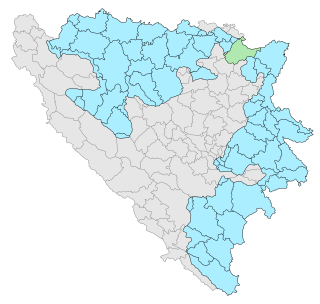| Udrežnje | |
|---|---|
| Village | |
| Coordinates: 43°12′28″N18°05′20″E / 43.20778°N 18.08889°E | |
| Country | Bosnia and Herzegovina |
| Entity | Republika Srpska |
| Municipality | Nevesinje |
| Time zone | CET (UTC+1) |
| • Summer (DST) | CEST (UTC+2) |
Udrežnje (Serbian Cyrillic : Удрежње) is a village in the municipality of Nevesinje, Republika Srpska, Bosnia and Herzegovina. [1]
The Serbian Cyrillic alphabet is an adaptation of the Cyrillic script for Serbo-Croatian, developed in 1818 by Serbian linguist Vuk Karadžić. It is one of the two alphabets used to write standard modern Serbian, Bosnian and Montenegrin, the other being Latin. In Croatian, only the Latin alphabet is used.

A village is a clustered human settlement or community, larger than a hamlet but smaller than a town, with a population ranging from a few hundred to a few thousand. Though villages are often located in rural areas, the term urban village is also applied to certain urban neighborhoods. Villages are normally permanent, with fixed dwellings; however, transient villages can occur. Further, the dwellings of a village are fairly close to one another, not scattered broadly over the landscape, as a dispersed settlement.

Under the "Law on Territorial Organization and Local Self-Government" adopted in 1994, Republika Srpska was divided into 80 municipalities. After the conclusion of the Dayton Peace Agreement, the law was amended in 1996 to reflect the changes to the entity's borders and now provides for the division of Republika Srpska into 64 municipalities.
According to the 2013 census, there are 189 inhabitants.
On June 2, 1941, Franjo Sudar's Ustaše attacked the Udrežnje village and killed 27 people of the Vujadinović, Vukosav, Draganić, Gambelić, Kljakić, Šipovac, Šakota and Škipina families. [2]
Vujadinović is a Serbian surname, derived from the male given name Vujadin, may refer to:
Šakota is a Serbian and Croatian surname, derived from a nickname itself from the word šaka, meaning "hand".



